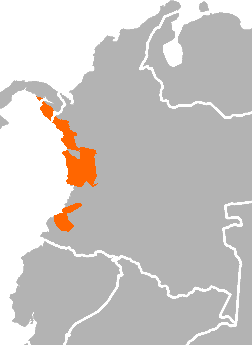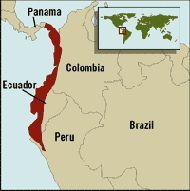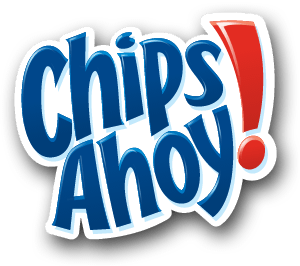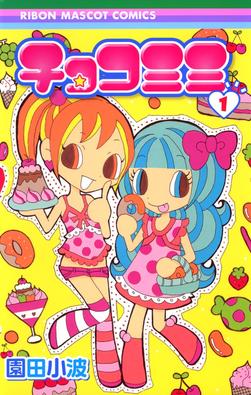Choco-Story may refer to:
- Choco-Story Brugge
- Choco-Story Brussels
- Choco-Story Colmar
- Choco-Story New York
- Choco-Story Playa del Carmen
Choco-Story may refer to:

Chocó Department is a department of the Pacific region of Colombia known for hosting the largest Afro-Colombian population in the nation, and a large population of Amerindian and mixed African-Amerindian Colombians. It is in the west of the country, and is the only Colombian department to have coastlines on both the Pacific Ocean and the Atlantic Ocean. It contains all of Colombia's border with Panama. Its capital is Quibdó.

The Choco languages are a small family of Native American languages spread across Colombia and Panama.

Tumbes-Chocó-Magdalena is a biodiversity hotspot, which includes the tropical moist forests and tropical dry forests of the Pacific coast of South America and the Galapagos Islands. The region extends from easternmost Panama to the lower Magdalena Valley of Colombia, and along the Pacific coast of Colombia and Ecuador to the northwestern corner of Peru. Formerly called the Chocó-Darién-Western Ecuador Hotspot, it has been expanded to include several new areas, notably the Magdalena Valley in northern Colombia. It is bounded on the east by the Andes Mountains. The Tumbes-Choco-Magdalena Hotspot is 1,500 km long and encircles 274,597 km². Tumbes-Choco-Magdalena is near the Pacific Ocean. The factors that threaten Tumbes-Choco-Magdalena are farming encroachment, deforestation, illegal crops, and population growth. Whereas the Panamanian and Colombian portion of the hotspot are relatively intact, approximately 98% of native forest in coastal Ecuador has been cleared, rendering it the most threatened tropical forest in the world. The hotspot includes a wide variety of habitats, ranging from mangroves, beaches, rocky shorelines, and coastal wilderness to some of the world's wettest rain forests in the Colombian Chocó. The hotspot includes a number of ecoregions:

Cocoa Krispies is a breakfast cereal produced by WK Kellogg Co, coming both as a boxed cereal and as a snack bar with a 'dried milk' covered bottom. It is a cocoa flavored version of Rice Krispies that contains real chocolate. In Canada, Rice Krispies Cocoa is their variant of the cereal, with a lighter chocolate flavor. Off-brand "coco krispies" are sold by other companies.
Choko may refer to:
Cauca may refer to:
Choco or Chocó may refer to:

The Embera-Wounaan are a semi-nomadic indigenous people in Panama living in Darién Province on the shores of the Chucunaque, Sambú, and Tuira Rivers and their waterways. The Embera-Wounaan were formerly and widely known by the name Chocó, and they speak the Embera and Wounaan languages, part of the Choco language family.

Chips Ahoy! is an American chocolate chip cookie brand, baked and marketed by Nabisco, a subsidiary of Mondelez International, that debuted in 1963. Chips Ahoy! cookies are available in different variations such as, original, reduced-fat, chunky, chewy, and candy-blasts; each can be identified by variations in the color of the package. For example, Chips Ahoy! original has blue color packaging, while Chips Ahoy chewy has a red packaging.
Chocolate is a food made from roasted and ground cacao seed kernels.

Choco Taco was a Good Humor-Breyers ice cream novelty resembling a taco. It consisted of a disk of waffle cone material folded to resemble a hard taco shell, reduced-fat vanilla ice cream, artificially flavored fudge, peanuts, and a milk chocolate coating. The Choco Taco was marketed under the Klondike brand as "The Original Ice Cream Taco".

A choco pie is a snack cake consisting of two small round layers of cake with marshmallow filling and a chocolate covering. The term originated in America but is now also used widely in South Korea, Japan, and its exports, and many other countries as either a brand name or a generic term. Names for similar confections in other places include chocolate marshmallow pie, Wagon Wheels, the Japanese angel pie, and moon pie.

Anthony Rubén Lozano Colón, nicknamed Choco, is a Honduran professional footballer who plays as a forward for La Liga club Almería, on loan from Getafe, and captains the Honduras national team.
Museum of Chocolate or Chocolate Museum may refer to:

ChocoMimi is a Japanese manga series written and illustrated by Konami Sonoda. It was first serialized in the magazine Ribon Original in 2003 and was moved to the main Ribon magazine in March 2004. The series was put on hiatus in the September 2019 issue of Ribon due to Sonoda's poor health, and she later died from breast cancer on August 4, 2019.
Riosucio may refer to:

Pancit choca is a Filipino black seafood noodle dish made with squid ink and bihon. It originates from Cavite, Philippines, and is originally known as pancit choca en su tinta in Caviteño Chavacano. It is also known more commonly as pancit pusit in Filipino. It is a type of pancit.
Gatoh Move Pro Wrestling, often referred to simply as Gatoh Move, is a Japanese Joshi puroresu promotion established in 2012 by Emi Sakura. The promotion is known for hosting shows in Tokyo at Ichigaya Chocolate Square, where there is no wrestling ring, but instead a small performing space in the shape of a square.
The golden-bellied warbler has been split into two species: